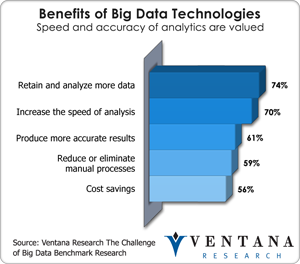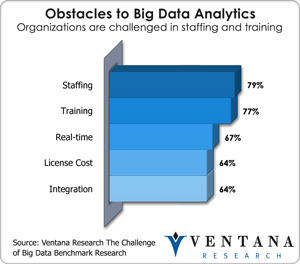In recent months I have been asked a straightforward question by several clients: How do you define big data in the context of human capital management? More specifically, the question isn’t so much about the classic definition of big data – which includes the storage and use of high volume of data, high velocity of data and high variety of data, commonly known as the 3Vs – but really has two parts: What are the key differentiators between analytics applications and big data applications, and to what degree must an application include external data to be considered big data? Ventana Research has been covering big data for some time, and my colleague Tony Cosentino wrote about big data and workforce Analytics last September. But both human capital management and big data have evolved since then, so I think it’s worth writing about again.
Let’s start with the first part of the question, about the key differentiators between big data and workforce analytics in human capital management. For the most part, business analytics in human capital management is historical – that is, it looks at past data and analyzes what happened in the past. In HR, people do this with spreadsheets, reports and business intelligence tools. But with big data, there is an opportunity to apply predictive analytics to the centralized store of data to understand potential future outcomes. In human capital management, one example of this potential is in workforce planning, where combining historical labor supply information and labor demand inputs can produce a predictive model of future workforce needs. (For a more general discussion of predictive analytics in big data, read Tony’s post on predictive analytics.) The second differentiator between big data and workforce analytics is the ability to apply analytical discovery against large volumes of data, which provides an intuitive way to interact with analytics through a variety of methods including visual and is a better way understand large volumes of data. There are several types of analytical discovery, which my colleague Mark Smith detailed. Both of these approaches are easier to adopt when big data technology is used; it can handle the challenges of managing data within the HR department.
The second part of the question is whether an organization can have big data that involves only internal data sets. The answer is yes. While there are many instances where big data and human capital management use external data, there are use cases where internal data sets are all that is needed. In short, it is best not to generalize but to look at the specific needs within the business processes of human capital management to draw answers. The following are two examples that illustrate how both sets of requirements can come together and paint a good picture of how big data is evolving in human capital management.
Hiring is probably the most important area of human resources in which big data is being applied today, and it is the application in which external data is used most prevalently. It is also the area where the data is used most often in a predictive fashion, to tell hiring managers which candidates, based on specific past information, will be good hires. Over the years much work has been done to build objective profiles of the traits that make for good hires in different positions throughout organizations, with the goal being to limit the subjective nature of hiring. Recruiting has used several external tools to start down this path, such as validated personality assessments, which profile candidates and use analytics to see where employees with certain strengths have done well in particular parts of their jobs. Now big data introduces larger sets of information and more powerful algorithms, and we see new companies such as Gild, which was recently featured in a New York Times story on how big data is playing recruiter for specialized positions. And in the Economist, an article “Robot Recruiters” details how some external data can help predict who will be better hires for certain hourly positions. These kinds of evolution can increase the success rate for hiring high-quality candidates. However, as Lazlo Bock, senior vice president of people at Google, said in the New York Times article “In Head Hunting, Big Data May Not be Such a Big Deal”, there are likely to be limits to the certainty with which big data can tell an organization about how well candidates will do in any job. Organizations still need to keep experienced managers in the process to get the best results.
Employee retention and engagement is another area of usage in this growing economy where big data is primed to grow; here organizations may already have much of the information internally. Key information for employee retention includes everything from compensation, HR, performance, employee development and learning information to benefit and even social network data. Organizations can look at this data and create effective statistical models that help them better predict where they should focus their employee retention efforts. Some application vendors, such as Ultimate Software, are starting to prepackage these kinds of big data tools. Ultimate Software also offers its Retention Predictor, which is built into the company’s analytics application.
In these two examples, we see how big data is becoming more  valuable within human capital management. Recruiting uses multiple external sources, while employee retention uses mostly internal data for analysis. Yet both areas can use predictive analytics against big data, employing existing data and statistical tools to provide decision-making guidance. And for both, as the variety of data gets more diverse, analytical discovery is required to understand the data successfully. Finally both examples are focused on delivering the benefits of big data, which we have highlighted in our benchmark research on the challenges of big data. Our research shows the top three benefits are the ability to retain and analyze more data (74%), increase the speed of analysis (70%) and produce more accurate results (61%).
valuable within human capital management. Recruiting uses multiple external sources, while employee retention uses mostly internal data for analysis. Yet both areas can use predictive analytics against big data, employing existing data and statistical tools to provide decision-making guidance. And for both, as the variety of data gets more diverse, analytical discovery is required to understand the data successfully. Finally both examples are focused on delivering the benefits of big data, which we have highlighted in our benchmark research on the challenges of big data. Our research shows the top three benefits are the ability to retain and analyze more data (74%), increase the speed of analysis (70%) and produce more accurate results (61%).
 Human capital analytics using big data and the application of business analytics are rapidly evolving, and many organizations are trying to master them in an effort to be more efficient and maintain their competitive advantage. Yet as our research finds, the largest obstacles to big data analytics are staffing and training (79%), and these areas will continue to be a challenge. For human capital analytics this means very large organizations that have existing practices in place may have an edge over smaller organizations. However, new applications are starting to arrive more rapidly and tools are becoming more readily available, which will likely help organizations better solve problems of leadership identification and development, productivity, retention, engagement and recruitment, among others. Overall, as human capital analytics gets smarter, the opportunity for human resources is significant, as these tools can provide competitive differentiation in attracting and retaining human capital.
Human capital analytics using big data and the application of business analytics are rapidly evolving, and many organizations are trying to master them in an effort to be more efficient and maintain their competitive advantage. Yet as our research finds, the largest obstacles to big data analytics are staffing and training (79%), and these areas will continue to be a challenge. For human capital analytics this means very large organizations that have existing practices in place may have an edge over smaller organizations. However, new applications are starting to arrive more rapidly and tools are becoming more readily available, which will likely help organizations better solve problems of leadership identification and development, productivity, retention, engagement and recruitment, among others. Overall, as human capital analytics gets smarter, the opportunity for human resources is significant, as these tools can provide competitive differentiation in attracting and retaining human capital.
Regards,
Stephan Millard
VP & Research Director











